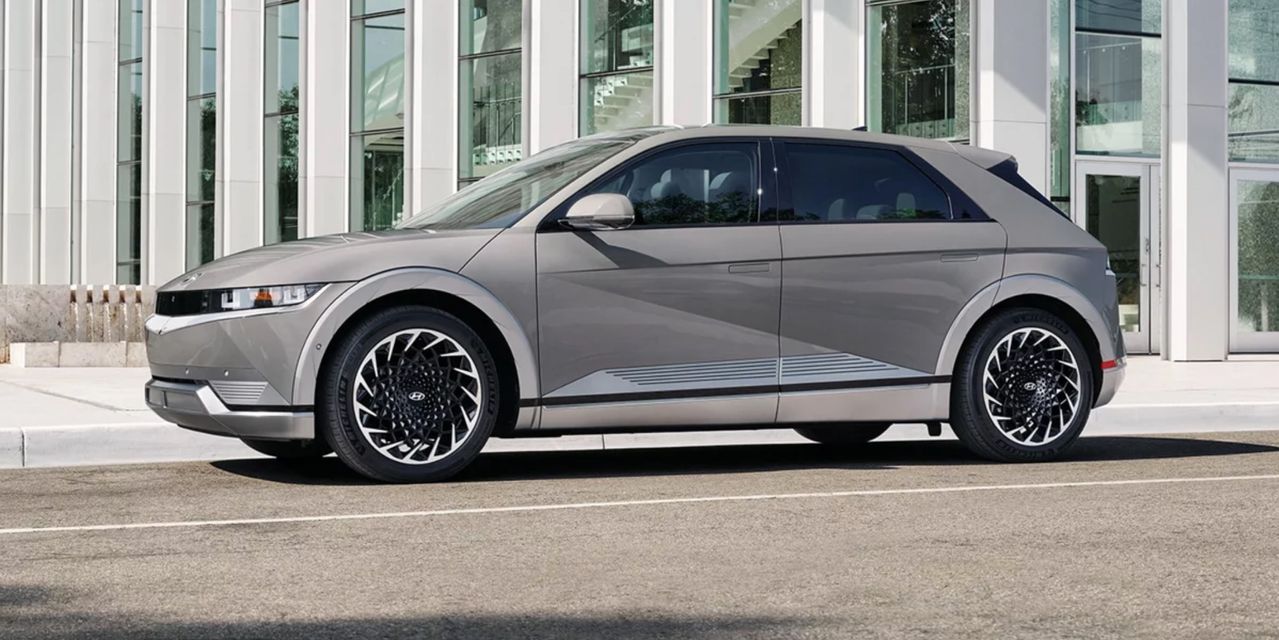The Hyundai Ioniq 5 is our highest-rated electric SUV and the recipient of two Best Buy Awards for 2023: Best Electric Vehicle and Best New Model. Pricing starts at $41,450.
More and more car buyers are wondering if their next purchase should be an electric vehicle. Not everyone can afford a Tesla
TSLA,
but a Nissan
NSANY,
Leaf may not cut it.
A fresh wave of electric vehicles has raised the excitement levels, though. Like the Kia EV6, the Ford
F,
Mustang Mach-E, and this. The Ioniq 5 offers plenty of tech, lots of standard equipment, great warranties, and battery capacities that make EV ownership an attractive proposition. All fashioned into an attractive package that looks like the very future it’s helping to create.
Coming off an abbreviated 2022 model year, KBB named the Ioniq 5 out Best New Model of 2023. It’s also the Electric Vehicle Best Buy of 2023, representing what we feel is the best electric vehicle for the most people.
The Ioniq 5 has also been named a Top Safety Pick+ by the Insurance Institute for Highway Safety. And from being sold in a select few areas to start, it’s now available virtually all across the United States.
See: The safest new cars of 2023
2023 Hyundai Ioniq 5 pricing
The 2023 Hyundai Ioniq 5 starts at $41,450. That’s for an SE RWD Standard Range, able to run for 220 miles on a single full charge.
The other SE with more power and a bigger battery starts at $45.5K. The highly recommendable SEL version is priced from $47,450. The top Limited trim comes in at $52.6K.
The 2023 Hyundai Ioniq 5
Hyundai
All-wheel drive entails a second electric motor, creating more combined power. It costs $3,500, or $3,900 in the Limited trim. A couple of premium paint finishes are $1,000.
The 2023 Hyundai Ioniq 5 is not currently eligible for the federal tax credit of up to $7,500.
Extra incentives are available in various states. California’s Clean Vehicle Rebate program, for example, awards $2,000 to anyone who buys or leases a new Ioniq 5. In conjunction with the Electrify America network, Hyundai
HYMTF,
also provides free 30-minute DC fast charges over two years.
Both the 2023 Hyundai Ioniq 5 and its Kia
000270,
EV6 counterpart (they share a platform and many other components) are priced below the Ford Mustang Mach-E (from about $47K) and well below the Tesla Model Y (around $66K). The Volkswagen ID.4 starts at about $38K and the Chevrolet Bolt EUV is a little over $28K.
Before buying a new Ioniq 5 electric vehicle, check the KBB.com Fair Purchase Price to see what others in your area paid for theirs. Demand for the Ioniq 5 is high, so we expect resale values to be strong.
Also see: The 2023 Ford Mustang Mach-E: The all-electric compact SUV is fast and thrilling
Smooth and quiet driving
Quiet, smooth, and quick when moving away from a standstill, driving a 2023 Ioniq 5 EV soon becomes second nature. Any learning curve for those coming straight from a conventional gasoline-powered car is short and shallow.
It feels stable and composed, a benefit of the low center of gravity made possible by the floor-mounted battery pack. So the Ioniq 5 moves sweetly between left and right turns.
The Hyundai Ioniq 5 has ultra-fast charging ability.
Hyundai
Naturally, the versions with all-wheel drive — and therefore the most muscle (320 horsepower and 446 lb-ft of torque) accompanied by the best grip and traction — provide the greatest entertainment, as well as confidence when the time comes to overtake.
With brake energy regeneration set to its highest level, the Ioniq 5 can come to a complete stop just by keeping the right foot off the accelerator. This is one-pedal driving, a neat trick exclusive to electric vehicles, and not so tiring in city traffic compared with the usual dance between the throttle and brakes.
Also on MarketWatch: The 2023 Hyundai Ioniq 6: What’s it like to drive, and when can you get one?
Modern and roomy interior
Something as cutting-edge as a 2023 Ioniq 5 electric vehicle should surely come with wireless Apple
AAPL,
CarPlay/Android Auto smartphone integration. But no, it’s cable connection all the way. However, if the main gripe about this car can be remedied by a $5 cord with a USB-A plug at one end, then Hyundai has done an amazing job.
The tech is still impressive, as demonstrated by the 12.3-inch driver information display and 12.3-inch infotainment system touchscreen combined into one sleek unit. The SEL adds wireless device charging and ambient cabin lighting, while the Limited trim comes with a head-up display enhanced by augmented reality (AR).
The top Limited version also has a huge single-pane glass roof, bringing extra airiness to a cabin that’s already spacious for what is essentially a compact SUV. The rear seats split, fold, slide and recline. Maximum rear legroom is 39.4 inches, more than a Toyota
TM,
RAV4. And it’s a flat floor throughout — no transmission tunnel, even with all-wheel drive.
Cargo space goes from 27.2 cubic feet behind the rear seats to 59.3 cubic feet when they’re folded down. There’s also a storage area of just under one cubic foot up front, beneath the hood. It’s somewhere to throw smelly gym clothes.
Plus: How much does it cost to charge an electric car? We do the math
Cutting-edge exterior
Gravity Gold Matte is a new color for the 2023 Ioniq 5 electric SUV. And the SEL loses the premium LED front lighting, but still has multifaceted reflector (MFR) LED headlights.
At this point, many of us have seen an Ioniq 5 in the wild and formed our own opinions. Our review staff appreciates how the clean, sharp lines of the body are contrasted with ornately mathematical alloy wheel designs. Aerodynamics also contributed to the hood design and flush-fitting door handles.
The raised ride height nudges this vehicle into the SUV category. Its ground clearance is a result of the floor-mounted battery pack, but will help when driving through snow.
Check out:The 2024 Honda Prologue: Honda’s new electric SUV is attractive and spacious. When can you get one?
Favorite features
Ultra-fast charging
The Ioniq 5’s batteries can cope with an 800-volt DC fast charger. All it takes is 18 minutes to go from 10% to 80% capacity. It’s still a relatively quick 25 minutes at a 400-volt setting.
Digital Key
Now standard in the SEL, this allows users with an Android-based smartphone to access the Ioniq 5. It’s easy to set up and authorize other people. For the time being, Apple iPhone owners can use a key card.
Hands-free liftgate operation with auto-open
Detecting the key’s presence, the powered liftgate opens automatically, so there’s no need to wave a foot under the bumper. This comes in at the SEL trim level.
Driver’s seat leg support
In the short-ish time it takes to recharge an Ioniq 5 EV, drivers can relax by reclining their power-adjustable seat and extending the leg support — like an airplane seat in business class. This is exclusive to the Limited trim, though.
Reverse charging
The correct jargon is vehicle-to-load, or V2L. It means that electricity can also be taken out of the battery (as long as it has at least 15% juice) to run something else, like lights or a laptop computer. It’s another standard feature in the Limited model.
Remote Smart Parking Assist
The Limited trim gets all the really cool stuff. Like this feature allowing drivers to inch their Ioniq 5 into or out of a parking space using remote control.
Read: 5 reasons you should hold off on buying an EV
Engine and transmission
Hyundai calls the least expensive new Ioniq 5 EV the SE RWD Standard Range, but it’s really the one with the smallest range: 220 miles (the greatest distance traveled on a full battery before a recharge is necessary). That’s still feasible for most commutes and general running around, though.
It’s achieved by a single electric motor making a respectable 168 horsepower and 258 lb-ft. This goes to just the rear wheels (RWD) through an automatic transmission.
In the RWD configuration, the rest of the lineup uses a motor developing the same amount of torque (perceived as thrust), but 225 horsepower (what the motor creates when working its hardest). A bigger battery is also fitted.
Range here is 303 miles, which is about 9 miles shorter than the Ford Mustang Mach-E (California Route 1 model) or 15 miles shy of the much pricier Tesla Model Y’s best figure.
All-wheel drive (AWD) adds a second motor to drive the front wheels — maximum output is 320 horsepower and 446 lb-ft of torque. Range is up by 10 miles for 2023, to 266 miles.
Upgrades to the lithium-ion polymer battery packs this year are the heating system and a preconditioning function for optimum efficiency.
Fast charging is another Ioniq 5 plus point. At a DC station running an 800-volt supply, both batteries could go from 10% to 80% in just 18 minutes. Or 25 minutes at 400 volts.
Going from 10% to completely full using a 240-volt home charger, the bigger battery requires just over seven hours. The smaller (standard range) setup does it in a little less than six hours.
For the odd person who needs to tow something with their new Ioniq 5 compact EV, the maximum rating has increased this year by 650 pounds to a total of 2,300 pounds. That’s with RWD or AWD. Towing is not recommended with the SE RWD Standard Range.
58-kWh battery and rear-wheel drive
168 horsepower
258 lb-ft of torque
EPA city/highway fuel economy: 127/94 MPGe
EPA-estimated range: 220 miles
77.4-kWh battery and rear-wheel drive
225 horsepower
258 lb-ft of torque
EPA city/highway fuel economy: 132/98 MPGe
EPA-estimated range: 303 miles
77.4-kWh battery and all-wheel drive
320 horsepower
446 lb-ft of torque
EPA city/highway fuel economy: 113/90 MPGe
EPA-estimated range: 266 miles
Also see: Your complete guide to MPGe, the electric equivalent of miles per gallon
Class-leading warranty
Hyundai always provides unbeatable warranties. The general new-car coverage is five years or 60,000 miles, whichever happens first. Both the powertrain and battery have a 10-year/100,000-mile warranty.
KBB’s car review methodology.
This story originally ran on KBB.com.
Read the full article here










